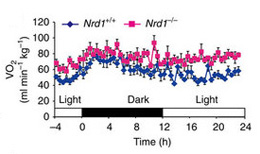Research Abstract
ナルディライジンは体温恒常性の維持に重要な役割を担う
Critical roles of nardilysin in the maintenance of body temperature homoeostasis
2014年2月4日 Nature Communications 5 : 3224 doi: 10.1038/ncomms4224

哺乳動物の体温恒常性は、主にふるえ熱産生と非ふるえ熱産生、それに皮膚の血管運動の調節を介して中枢生に管理されている。褐色脂肪組織(BAT)での非ふるえ熱産生は、交感神経活動の亢進によって誘導されるPGC-1αがUCP1を活性化することで生じる。今回我々は、ナルディライジン(Nrd1およびNRDc)が体温恒常性の重要な調節因子であることを明らかにした。Nrd1-/-マウスは、BATでの熱産生および身体活動量の増加により、エネルギー消費が増大している。これらの所見にもかかわらず、Nrd1-/-マウスは低体温症、寒冷不耐性を呈するが、その原因は体温セットポイントの低下、断熱性低下、寒冷環境で必要な追加熱産生の欠如にあることが分かった。寒冷環境下で生じるβ3アドレナリン受容体、PGC-1αおよびUCP1の発現誘導は、NRDcが存在しないと大きく障害される。分子レベルでは、NRDcはPGC-1αと結合してUCP1のエンハンサー領域に共局在し、そこでPGC-1α活性を抑制する。これらの知見は、NRDcの新たな核内での機能を明らかにするとともに、熱調節の分子機構解明に重要な手掛かりを与えるものだ。
平岡 義範1*, 松岡 龍彦1, 大野 美紀子1, 中村 和弘2, 西城 さやか1, 松村 成暢3, 西 清人1, 坂本 二郎1, 陳 博敏1, 井上 和夫3, 伏木 亨3, 北 徹4, 木村 剛1 & 西 英一郎1
- 京都大学大学院 医学研究科 循環器内科学
- 京都大学・生命科学系キャリアパス形成ユニット
- 京都大学大学院農学研究科 食品生物科学専攻 栄養化学分野
- 神戸医療センター 中央市民病院
*現所属先: 神戸学院大学 薬学部 臨床薬学部門
Body temperature homoeostasis in mammals is governed centrally through the regulation of shivering and non-shivering thermogenesis and cutaneous vasomotion. Non-shivering thermogenesis in brown adipose tissue (BAT) is mediated by sympathetic activation, followed by PGC-1α induction, which drives UCP1. Here we identify nardilysin (Nrd1 and NRDc) as a critical regulator of body temperature homoeostasis. Nrd1−/− mice show increased energy expenditure owing to enhanced BAT thermogenesis and hyperactivity. Despite these findings, Nrd1−/− mice show hypothermia and cold intolerance that are attributed to the lowered set point of body temperature, poor insulation and impaired cold-induced thermogenesis. Induction of β3-adrenergic receptor, PGC-1α and UCP1 in response to cold is severely impaired in the absence of NRDc. At the molecular level, NRDc and PGC-1α interact and co-localize at the UCP1 enhancer, where NRDc represses PGC-1α activity. These findings reveal a novel nuclear function of NRDc and provide important insights into the mechanism of thermoregulation.

